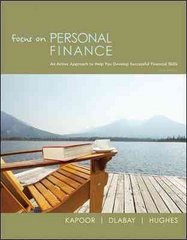Question
Dusty Barnes runs a solo operation crop-dusting business and in late November is considering whether to expand his operations by acquiring another plane and pilot.
| Dusty Barnes runs a solo operation crop-dusting business and in late November is considering whether to expand his operations by acquiring another plane and pilot. He books his orders in winter, in advance of the actual operations in summer. He knew that as in previous years, he would soon be turning away business since his calendar was already booked through July. Barnes expected the new plane would set him back by $100,000. With an additional pilot he expected to be able to work the plane hard for five years and then be able to sell it for about $60,000. Barnes anticipated the WACC for commercial crop dusting firms was currently 8.5% but he knew his local bank would lend him the money for 5 years at 6%. Barnes knew that an old friend of his who had retired at an early age from the city to move to the countryside was a capable pilot and had time on his hands. He could hire him for $85,000 for the season, and an assistant pilot at $40,000. His accountant informed him that the plane would be depreciated for tax purposes over 10 years on a straight line basis. It was an important shield from the current rate of tax of 40%. Dusting services tended to come with payment terms that allowed 30 days of credit. The incremental storage, maintenance and insurance costs were expected to be $20,000 per year. The going price for crop dusting was $20 an acre. Barnes estimated that he could easily book at least an additional 10,000 acres for the upcoming season if he had the new plane. Fuel costs were $3.75 an acre. He estimated that inflation would be 3% each year. His numbers were as follows: | |||||||
| Additional acres | 10,000 | ||||||
| Price per acre $ | 20 | ||||||
| Fuel cost per acre $ | 3.75 | ||||||
| Annual cost of pilot | 85,000 | ||||||
| Annual cost of assistant $ | 40,000 | ||||||
| Storage, maint, insurance $ | 20,000 | ||||||
| Receivable days | 30 | ||||||
| Initial cost of plane $ | 100,000 | ||||||
| Salvage value of plane Yr 5 $ | 60,000 | ||||||
| Depreciation rate | 10% | ||||||
| Tax rate | 40% | ||||||
| Discount rate | 8.50% | ||||||
| He decided to test the viability at 8.5% to see if the operation would still be profitable. Appropriate discount rates reflect the risk of the cash flows, not how the investment was financed. Barnes arrived at the free cash flows from operations by EBIT x (1-tax rate). Net working capital forecast was determined based on incremental accounts receivable based on the new plane.Increase in net working capital was simply the net change in total working capital each year. He makes all his payments in cash, and the inventory stores belong to his clients, so his inventory is zero. Barnes estimates that he will have to fund the receivables until Year 5. In Year 5 he incorporates a terminal value for working capital by simply bringing the net working capital back to zero. Although he will be able to sell the plane for $60,000 he will have to pay a capital gains tax of $4000 on it (Sale value-book value) X tax rate. What will be the Net Present Value with these assumptions? Should he go for the expansion? | |||||||
Step by Step Solution
There are 3 Steps involved in it
Step: 1

Get Instant Access to Expert-Tailored Solutions
See step-by-step solutions with expert insights and AI powered tools for academic success
Step: 2

Step: 3

Ace Your Homework with AI
Get the answers you need in no time with our AI-driven, step-by-step assistance
Get Started


